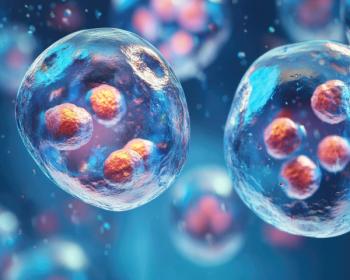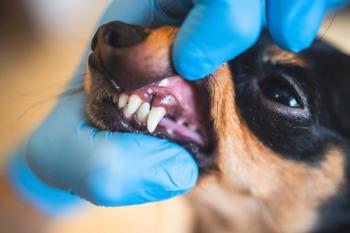
Oral diagnosis: Hard tissue valuation (Proceedings)
The term "Oral Exam" usually denotes to most practitioners elevation of the patient's lips on the exam table and observing the pathology present.
The term "Oral Exam" usually denotes to most practitioners elevation of the patient's lips on the exam table and observing the pathology present.
As you delve into veterinary dentistry it will soon become apparent only superficial information will be gained in this manner. Only a relative small percentage of dental lesions will be detected upon initial examinations.
This limitation of information is the result of:
A) Masking secondary to calculus accumulation.
B) Many periodontal lesions are only detectable with periodontal explorer probing of the sulcus.
C) Lack of patient cooperation to allow proper visualization especially of the posterior dentition as well as the lingual/palatal aspects of all the teeth.
D) Many lesions are "hidden" thus requiring radiography for demonstration.
Dentistry in veterinary medicine utilizes all of the disciplines practiced in human dentistry; such as orthodontics, periodontics, endodontics, oral surgery, restorative plus intraoral radiology and crown and bridge. A complete oral examination includes both hard tissue and soft tissue evaluation for pathology, anatomy, and genetics. The hard tissues consisting of the teeth and osseous structures. The soft tissues the lips, cheeks, tongue, palate, gingiva, and oral mucosa.
Developmental Evaluation
Hard tissue evaluation, in terms of growth and bite relationships, is placed under the discipline of orthodontics. Orthodontics, by definition, is the correction or placement of malaligned teeth into their proper relationship in the dental arches through mechanical and occasionally surgical means.
Orthodontics cannot begin without our understanding of proper tooth alignment, genetic relationship, developmental defects and their etiologies, with strong consideration for the ethical of tooth movement.
Hard tissue diagnosis also includes, supernumerary teeth, missing teeth, rotate teeth, fusion, trauma, and coronal defects.
Soft tissue diagnosis evaluates normal and abnormal anatomy, pathology, and soft tissue trauma.
Both hard and soft tissue diagnosis must be made with attention to treatment modalities.
Adult dogs have forty-two teeth.
The formula for dogs is: (3-3 1-1 4-4 2-3) x 2 = 42.PM4/M1 are the carnassials teeth. Dogs have twenty single rooted teeth (twelve incisors, four canines and four first premolars). The upper fourth premolar and upper molars are three-rooted. The rest of the teeth are two-rooted.
Cats have thirty teeth.
The formula for cat's is:(3-3 1-1 2 1-1) x 2 = 30. PM4/M1 are the carnasial teeth. The carnasial teeth in cats are the upper third premolar and the lower first molar.
Positional Terminology
Anterior: situated in front of; commonly used to the incisor teeth or forward region of the mouth.
Apical: toward the apex (tip) of the tooth.
Coronal: toward the tooth crown.
Cervical: the portion of the tooth near the junctional gingiva
Normal and Abnormal
The surfaces of the tooth are as follows: the mesial surface is the rostral portion of the tooth closest to the midline; the distal surface is the caudal aspect adjacent to the next tooth behind; the labial surface is closest to the lip; the buccal surface faces the cheek; the lingual surface faces the tongue (lingual refers to lower dentition only: premolars and molars); palatal aspect is used to denote medial surface of upper premolars and molars only. Upper and lower incisors in dogs are anterior teeth; upper and lower premolars and molars are posterior teeth. The occlusal surface on the other teeth simply indicates that they face the opposite arch.
Buccal surface: the outer surface of the tooth near the cheek
Distal surface: the surface of the tooth nearest the molar.
Incisal edge: the biting surface of an anterior tooth
Labial surface: the outer surface of the tooth near the lip.
Lingual surface: the tongue side of lower teeth
Mesial surface: the surface of the tooth nearest the central incisors
Palatal surface: the palate side of upper teeth
Proximal surface: the surface between the teeth
Brachygnathic (overshot), prognathic (undershot) and wry bites are genetic defects. At this writing, the only diagnosis to determine genetic from developmental bite relationships is based on A. H. Angle's classification developed before the turn of the century, prior to radiographic and cephalometric evaluation of skeletal growth patterns as related to the teeth and their arrangement in the mouth.
Until we can properly evaluate the total picture of the skeletal and dental patterns by establishing cephalometric normal for all the breed types (mongrels excluded), we may have to classify bite relationships based upon the dentition only. The most common bite types are usually divided into Normal occlusion or bite malocclusions, such as brachygnathic or overshot and prognathic or undershot and wry. These bite relationships are based in part on molar/premolar relationships. In normal occlusion the premolar/molar relationship shows the lower posterior (cheek) teeth to be rostral (anterior) to their counterparts: the cusp tips pointing to the center of the opposing interproximal space. Thus the lower first premolar is rostral to the upper first premolar, the lower second premolar is rostral to the upper second premolars and so forth. In brachygnathic malocclusion the upper first premolar opposes the lower first premolar and so forth. The degree of upper premolar rostral displacement is contingent upon the degree of involvement.
In mandibular prognathism the opposite premolar relationship is seen, in that the upper premolars are caudal to their normal position (example: the upper first premolar opposing the lower second premolar). These classifications are based solely upon tooth position with no reference to skeletal relationship.
There is no human classification for wry bite, this malocclusion does rarely occur in man. An advanced wry bite relationship is a unilateral prognathism that affects not only the teeth, but the whole headpiece as well. There is a deviation of the midline, a unilateral open bite and cranial asymmetry. However wry malocclusion can show only a slight amount of the defect; that is only the dentition affected to a slight degree with or without a midline deviation. An occlusal radiograph usually is diagnostic of this condition.
Most occlusal patterns, retained primary teeth. Missing teeth and supernumerary teeth are genetic in origin. This presents an ethical problem when orthodontics is considered for cosmetic purposes only. Soft tissue trauma as a result of teeth out of alignment is to be relieved. However most soft tissue trauma cases can be relieved by simple tooth length reduction through vital Pulpotomy procedures.
Genetics of Occlusion
The etiology of dental malocclusion in dogs and cats has been explored to a large degree in recent years due to the strong emphasis on veterinary dentistry.
Vetodontics receive much of their information from human orthodontics literature and the modifications proposed by veterinary studies and theories. It was believed by early orthodontists that malocclusions in general were diseases of civilization and improper jaw function. With the development of genetic research, malocclusions were found to be the result of inherited dento facial proportions that are altered by developmental variations, trauma or altered function.
Certain bites or occlusal relationships are influenced by years of established breeding within a family or breed. If we consider normal occlusion to be one where there is normal molar premolar relationship, the line of occlusion is a smooth curve, and the incisors in scissor relationship, then all other relationships are in malocclusion to a greater or lesser degree. These include class I, II, and III malocclusions
Malocclusion in our small animals is either inherited from disproportionate tooth size to jaws size, or from disproportionate size of upper to lower jaws. Therefore, small teeth and large jaws or large maxilla and small mandible or any combination of the above could be inherited.
These disproportions in size are usually not seen in the wild, primitive, or perhia specimens, Malocclusions were breed out due to improper function and survival of the fittest specimens. Genetic isolation of species usually produces uniformity in occlusion with disturbances in jaw discrepancies in tooth size-and jaw size imbalances. Experiments concluded that independent inheritance of facial characteristics could be a major cause of malocclusion and often the result of increased out breeding.
A misleading factor of many breeds of small dogs is their gene for achondroplasia. Animals or humans affected by this condition have deficient growth of cartilage. The result is extremely short extremities and an underdeveloped midface. The dachshund is the classic achondroplastic dog, but most terriers and bulldogs also carry this gene. Achondroplasia is an autosomal dominant trait. Like many dominant genes, the gene for achondroplasia sometimes has only partial penetrance, meaning simply that the trait will be expressed more dramatically in some individuals than in others. The unusual malocclusions produced in Stockard's breeding experiments can be explained, not on the basis of inherited jaw size, but by the extent to which achondroplasia was expressed in that animal.
This resultant out crossed animals produced severe skeletal, dental relationship and soft tissue problems as well. The brachycephalic and extreme brachycephalic breeds have restricted airway problems with resultant cardio-pulmonary complications. When we bred for the micrognathic maxilla, the genetic make up fails to carry the gene to produce compatible soft tissue size. The soft palate, the lateral nasal cartilage and the tracheal rings, to name a few, all compromise and restrict the airway.
The premolars and molars of the maxilla rotate out of alignment due to crowding, with complicating periodontal disease seen in teeth out of alignment.
There is a predominance of accompanying wry in the extreme brachycephalic breeds, often with cranial-facial asymmetry.
The continuance of malocclusal problems is largely influenced by people in dog show conformation competition. The average time spent in show competition is three to five years. In that time span much damage can be is often produced. Breeders seem to breed to what is winning rather that what is correct. Often what wins is not correct
Newsletter
From exam room tips to practice management insights, get trusted veterinary news delivered straight to your inbox—subscribe to dvm360.






